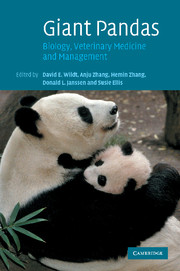Book contents
- Frontmatter
- Contents
- List of contributors
- Foreword
- Acknowledgements
- 1 The giant panda as a social, biological and conservation phenomenon
- 2 The Giant Panda Biomedical Survey: how it began and the value of people working together across cultures and disciplines
- 3 Factors limiting reproductive success in the giant panda as revealed by a Biomedical Survey
- 4 Significant medical issues and biological reference values for giant pandas from the Biomedical Survey
- 5 Life histories and behavioural traits as predictors of breeding status
- 6 Nutrition and dietary husbandry
- 7 Male reproductive biology in giant pandas in breeding programmes in China
- 8 Endocrinology of the giant panda and application of hormone technology to species management
- 9 The value and significance of vaginal cytology
- 10 Parentage assessment among captive giant pandas in China
- 11 The science of behavioural management: creating biologically relevant living environments in captivity
- 12 Evaluating stress and well-being in the giant panda: a system for monitoring
- 13 The neonatal giant panda: hand-rearing and medical management
- 14 Consequences of early rearing on socialization and social competence of the giant panda
- 15 Medical management of captive adult and geriatric giant pandas
- 16 Diseases and pathology of giant pandas
- 17 Ultrasonography to assess and enhance health and reproduction in the giant panda
- 18 Gastrointestinal endoscopy in the giant panda
- 19 Historical perspective of breeding giant pandas ex situ in China and high priorities for the future
- 20 Role and efficiency of artificial insemination and genome resource banking
- 21 Analysis of demographic and genetic trends for developing a captive breeding masterplan for the giant panda
- 22 Partnerships and capacity building for securing giant pandas ex situ and in situ: how zoos are contributing to conservation
- Index
- Plate Section
- References
20 - Role and efficiency of artificial insemination and genome resource banking
Published online by Cambridge University Press: 09 August 2009
- Frontmatter
- Contents
- List of contributors
- Foreword
- Acknowledgements
- 1 The giant panda as a social, biological and conservation phenomenon
- 2 The Giant Panda Biomedical Survey: how it began and the value of people working together across cultures and disciplines
- 3 Factors limiting reproductive success in the giant panda as revealed by a Biomedical Survey
- 4 Significant medical issues and biological reference values for giant pandas from the Biomedical Survey
- 5 Life histories and behavioural traits as predictors of breeding status
- 6 Nutrition and dietary husbandry
- 7 Male reproductive biology in giant pandas in breeding programmes in China
- 8 Endocrinology of the giant panda and application of hormone technology to species management
- 9 The value and significance of vaginal cytology
- 10 Parentage assessment among captive giant pandas in China
- 11 The science of behavioural management: creating biologically relevant living environments in captivity
- 12 Evaluating stress and well-being in the giant panda: a system for monitoring
- 13 The neonatal giant panda: hand-rearing and medical management
- 14 Consequences of early rearing on socialization and social competence of the giant panda
- 15 Medical management of captive adult and geriatric giant pandas
- 16 Diseases and pathology of giant pandas
- 17 Ultrasonography to assess and enhance health and reproduction in the giant panda
- 18 Gastrointestinal endoscopy in the giant panda
- 19 Historical perspective of breeding giant pandas ex situ in China and high priorities for the future
- 20 Role and efficiency of artificial insemination and genome resource banking
- 21 Analysis of demographic and genetic trends for developing a captive breeding masterplan for the giant panda
- 22 Partnerships and capacity building for securing giant pandas ex situ and in situ: how zoos are contributing to conservation
- Index
- Plate Section
- References
Summary
INTRODUCTION
Historically, the breeding of giant pandas in ex situ programmes has been difficult due to behavioural incompatibility and interanimal aggression. Because some individuals fail to mate naturally, the potential loss of valuable genes is a major concern to effective genetic management (see Chapter 21). Consistently successful artificial insemination (AI) would allow incorporating genetically valuable males with behavioural or physical anomalies into the gene pool. This strategy becomes even more powerful when used in the context of a genome resource bank (GRB), an organised repository of cryopreserved biomaterials (tissue, blood, DNA and sperm) (see Chapter 7). The use of sperm cryopreservation and AI allows the movement of genes among zoos and breeding centres without needing to transfer animals, which is both stressful and costly.
‘Assisted breeding’ refers to the tools and techniques associated with helping a pair of animals propagate, from AI to embryo transfer to cloning, among others (Howard, 1999; Pukazhenthi & Wildt, 2004). With the exception of AI, there is not much need for most other assisted-breeding techniques for the giant panda. As will be demonstrated here, AI is quite adequate for dealing with most cases of infertility or with helping to maintain adequate gene diversity in the captive population. In fact, the major breeding facilities, especially the China Conservation and Research Centre for the Giant Panda (hereafter referred to as the Wolong Breeding Centre) and the Chengdu Research Base of Giant Panda Breeding, routinely use AI to increase pregnancy success.
- Type
- Chapter
- Information
- Giant PandasBiology, Veterinary Medicine and Management, pp. 469 - 494Publisher: Cambridge University PressPrint publication year: 2006
References
- 7
- Cited by

